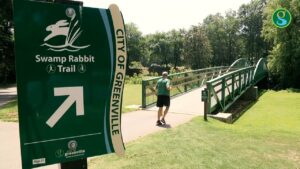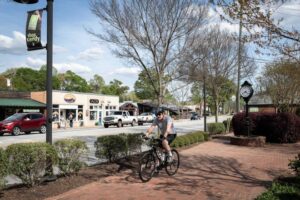Prisma Health Swamp Rabbit Trail System, Greenville South Carolina

By Steven Pelissier
The Prisma Health Swamp Rabbit Trail System includes 25 miles of walking and biking trails, stretching from the City of Travelers Rest, through the campus of Furman University, downtown Greenville, and a large city park to its terminus in the Conastee Nature Preserve, near Mauldin, SC. The trail enhances the quality of life of the community, enjoys significant use by locals, has become a major tourist attraction, and is a catalyst for economic development.

Planning for the trail began in 1999, with the creation of the Greenville County Economic Development Corporation. That organization’s first act was to purchase the abandoned Greenville and Northern Railway line. Construction on the main segment of the trail began in 2007, at a cost of $ 2.7 million. A gift of $ 1 million from the Greenville Health System (which subsequently became Prisma Health) was a huge boost to the project. As additional segments of the trail have been added over time, the total development cost is approaching $ 9 million, with additional extensions in the works. Four ARC investments have contributed a total of $ 1.2 million toward construction.

Economists estimate that the trail’s annual economic impact to the community exceeds $ 7 million. Property values and rental demand for commercial spaces along the corridor have increased dramatically, with tens of thousands of users being drawn to the trail each year. Prior to the trail’s opening, nearly one-third of the store fronts on the Main Street of Travelers Rest were vacant, with not much happening around the town. Today, demand for space in the town is incredible as the businesses and restaurants that originally opened to serve the trail have transformed the town into a trendy dining and entertainment center, attracting people from all over the region.
In a similar manner, the Swamp Rabbit has transformed the western portion of Greenville, which had been largely abandoned and decaying since the closure of textile mills in the 1970’s and 1980’s. That area has become Greenville’s hot spot for residential development, hip restaurants, and entertainment. While the trail is not the only aspect of Greenville’s marketing strategy, it expands on and enhances the natural resource asset based strategy for its development and marketing.

People often ask how the Swamp Rabbit got its name. Back when the line operated as a railroad, passengers noted the numerous unique looking large, big headed, short furred rabbits that lived along the route leading it to be nicknamed “The Swamp Rabbit Line.” This name was carried over to the trail.